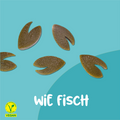Why tick protection is essential for dogs
Ticks lurk in tall grass, undergrowth, and even at the edge of forests, waiting for their victims. They can be found not only in nature but also in gardens and parks. A tick bite often goes unnoticed, and therein lies the danger: The pathogens enter the bloodstream during the bite and can cause symptoms even weeks later.
Particularly dangerous diseases for dogs:
- Lyme disease can damage joints, nervous system and organs
- Anaplasmosis causes fever, fatigue and blood clotting disorders
- Babesiosis destroys red blood cells and can be fatal if left untreated
- TBE (tick-borne encephalitis) is not only transmitted to humans, but in rare cases can also be dangerous for dogs living in high-risk areas. Typical symptoms can include fever, neurological deficits, and behavioral changes.
The sooner a tick is removed, the lower the risk. Therefore, daily checks are just as important as the use of tick repellent.
Tick repellent for dogs
There are various approaches to protecting your dog from ticks – from highly effective chemical products to gentle, natural remedies. The choice depends on individual factors such as coat type, the dog's lifestyle, and any intolerances.
Chemical tick repellents
- Chemical preparations generally offer the most reliable protection. They often last for several weeks or even months, making them particularly practical.
- Spot-on preparations: Liquid is applied to the neck, spreads over the skin and kills ticks before they bite or shortly after.
- Tick protection collars: Release active ingredients continuously and often last 6-8 months.
- Chewable tablets: Have a systemic effect; the tick dies while sucking blood.
Advantage: High effectiveness and long duration of protection.
Disadvantage: Some dogs react with skin irritation or gastrointestinal problems.
Natural tick protection for dogs
Perhaps you'd like to protect your dog from tick bites without chemicals. Natural remedies can be an alternative or supplement to chemicals. However, natural tick protection often has a shorter duration of effectiveness.
- Coconut oil: Can be massaged into the fur; the lauric acid it contains has a deterrent effect.
- Black seed oil: Can be mixed into your cat's food after consulting your veterinarian, as its strong scent can deter ticks. However, you should first rule out allergies or other pre-existing conditions, such as liver problems. But be careful: Black seed oil is not suitable for your cat, as it is toxic.
- Essential oils: For example, you can use lemon eucalyptus in a highly diluted form and apply the mixture to your dog's fur on the legs, chest, neck, and base of the tail.
These methods are particularly suitable if your dog is sensitive to chemical agents or as an additional measure in combination with conventional remedies.
Daily tick check
No matter which treatment you choose, checking your dog regularly after walks is still a must. You should check daily, especially during peak tick season.
Pay special attention to places like:
- Head and ears
- neck area
- Between the toes
- stomach and armpits
Special tick tweezers or tick cards are suitable for removal. It's important to grasp the tick as close to the skin as possible and pull it out slowly to avoid tearing off the head.










